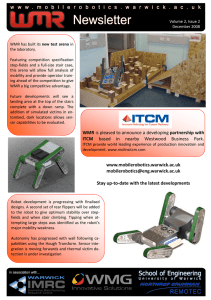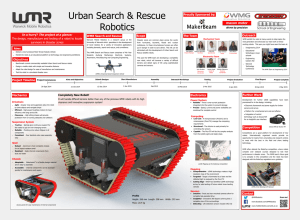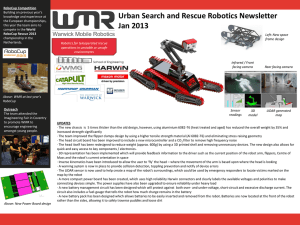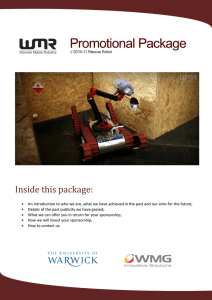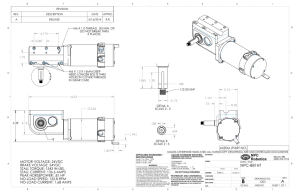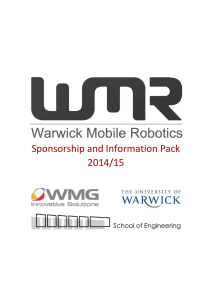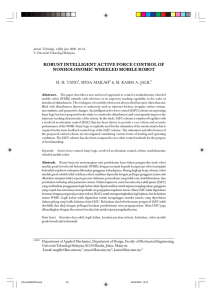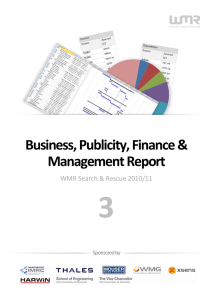1 Executive Summary
advertisement
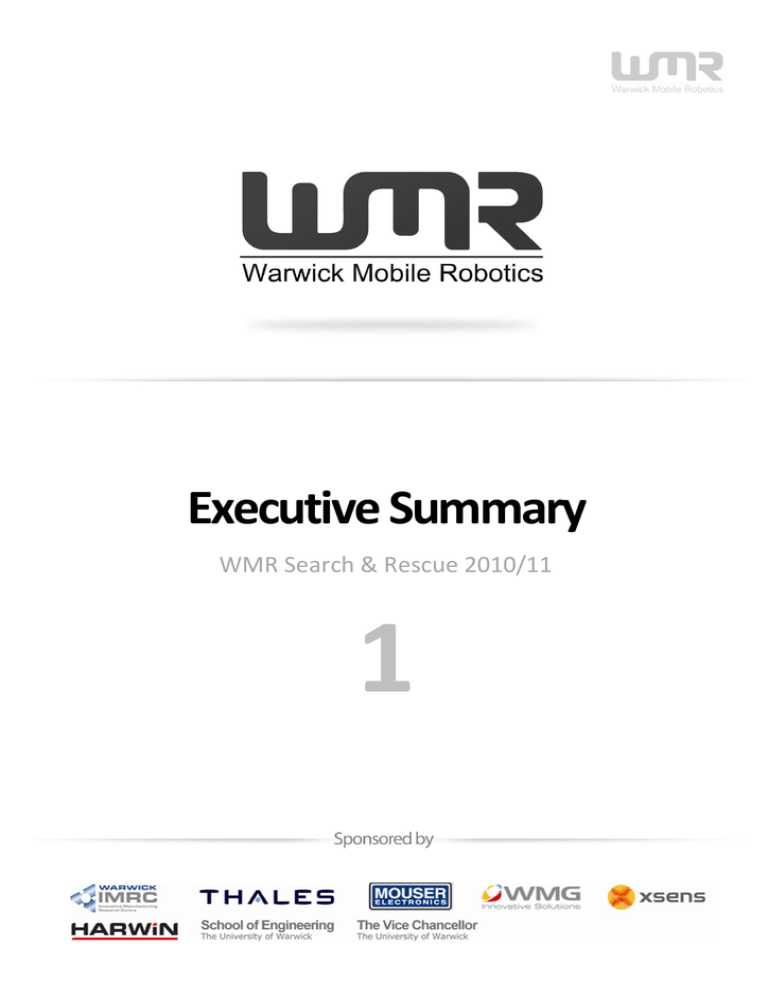
Executive Summary WMR Search & Rescue 2010/11 1 2010/11 WMR Executive Summary Table of Contents Table of Contents ............................................................................................... 1 1 Introduction ................................................................................................ 2 2 Aims and Objectives..................................................................................... 3 3 Commercial Opportunities .......................................................................... 4 4 Key Outcomes .............................................................................................. 5 5 Conclusions ................................................................................................. 8 Executive Summary | 1 2010/11 WMR Executive Summary 1 Introduction The Warwick Mobile Robotics (WMR) student research project is an inter-departmental collaborative effort at the University of Warwick tasked with developing robotic platforms for search and rescue missions in urban disaster zones. As a means of testing the Urban Search And Rescue (USAR) platforms developed each year, WMR compete in the RoboCup Rescue League, a global competition who’s goal is to “develop and demonstrate advanced robotic capabilities for emergency responders using annual competitions to evaluate, and teaching camps to disseminate best-in-class robotic solutions.” The robots compete for points and best in class ability in mobility, manipulation and autonomy by identifying victims and overcoming obstacles in a simulated disaster environment. Figure 1 The competing teams at the RoboCup German Open 2011 The group’s overall aims are to excel in all areas of the competition thanks to a variety of features on the robot, to research the commercial application of the project in greater detail than previous years and providing the next year’s team with a platform that is sufficiently documented upon hand-over. Our technical focus this year has been improving the USAR-T (teleoperated) platform, and upgrading the USAR-A (autonomous) platform’s mobility through the transferral of designs from the USAR-T. Autonomy and SLAM mapping also continues to be developed through the computer science team’s USAR-A platform in the addition of new sensor infrastructure such as the Xbox Kinect. Executive Summary | 2 2010/11 WMR Executive Summary The structure of the team is essential to implementing effective leadership and intercommunication between the teams involved. A horizontal hierarchy approach was utilised in the structuring of the team, with strategy meetings occurring weekly for continuous decision-making and progress tracking in addition to more regular informal meetings. This way it was ensured that every team member had an overview of the direction the project was taking and took part in the decision making process. With the computer science team’s work on the USAR-A, they were also incorporated into this structure. Jonathan Greensmith WMR Project Manager Mechanical Engineer Adam Land Workshop Manager Neil Timms Laser Cutting Technical Staff Alistair Adams Web and Graphics Mechanical Engineer Matthew Broxham Safety Officer Systems Engineer Christopher Holmes Secretary Electronic Engineer Systems Team Peter Crook Finance Officer Mechanical Engineer Matthew Dodds Publicity Officer Electronic Engineer Alex Pallister Sponsorship Officer Manufacturing and Mechanical Electronics Team Chris Couzens CS Project Manager SLAM Team Matthew Carter Victim ID Team Peter Moffat SLAM Team Matthew Maynes Victim ID Team SLAM Team Victim ID Team Computer Science Team Mechanical Team Figure 2: Organisational Structure of team and roles 2 Aims and Objectives The overall aim of this project is to continue the development of the two Warwick Mobile Robotics rescue robots; the USAR-A and USAR-T. The initial goal is to address the weaknesses in the current robots identified by the previous team. In addition to this, the current team also aims to develop a manipulator solution on the USAR-T robot, and to design and implement any other changes to the robots identified by a full SWOT analysis of each platform. The changes identified were: A complete redesign of the arm with specific attention to the joints A restructuring of both the server and client software systems Manufacturing a new chassis and drive train for the autonomous robot This year’s team also aims to investigate the commercial viability of the platform in order to determine whether turning the project into a sellable product is feasible. Executive Summary | 3 2010/11 WMR Executive Summary 3 Commercial Opportunities This year’s team has considered the commercialisation of WMR’s USAR robots more fully than any previous years. A meeting with David Calvert, the Business Development Manager of Warwick Ventures Ltd, provided the team with an insight into various options regarding protection of WMR’s intellectual property and pathways towards creating a saleable product. This process involved analysing WMR’s internal business strengths and weaknesses, as well as external market research. The USAR platform’s unique selling point, and biggest strength, is that they provide a full system solution to search and rescue requirements. Integrated into one system is mobility required to reach victims caught in hazardous environments, as well as all the sensors needed to locate them and map internal building dimensions for emergency services. A product such as this is not available commercially on the market at the moment. Alternatives used in disaster zones currently are bomb disposal robots leased out to government agencies for use, for example the Remotec Wheelbarrow (Northrop Grumman, 2011). WMR sits in a very advantageous position in current markets, despite global economic recovery still prevalent. Due to the numerous natural disasters over the past few months, there has been an increase in global awareness of the need for equipment to aid in search and rescue operations. It is due in part to this that WMR has received international media coverage across television, radio, newspapers, magazines, online media, and public exhibitions throughout this year. This has all served to reinforce the strength of the WMR brand and increase awareness of the Urban Search and Rescue project. The various customers were considered carefully and were concluded to most likely be a mix of government agencies, such as the emergency services; non-governmental organisations, such as charities; and safety departments of companies, such as mining companies. The largest part of this is likely to involve companies and organisations with stringent budgets, with a strong emphasis on cost-focussed competitive tendering. It is predicted that most governmental agencies are more likely to lease out robots such as these when required, due to the infrequency of natural disasters. Despite this, WMR has received speculative enquiries throughout the year regarding the cost and sale of these products, and WMR predict there still being a demand for the USAR robots. During market research, it was found there are no current competitors to either the USAR-A or USAR-T robots. This means there is the potential for supernormal profits during initial stages of commercialisation, brought about by a monopolistic hold of a new market. However, a highly significant and unfortunate factor affects WMR’s ability to perform Executive Summary | 4 2010/11 WMR Executive Summary commercially. A key requirement of the RoboCup Challenge that WMR compete in annually is to provide a public record of all technical reports from the team. This ultimately means any technical information is publicly available and therefore unable to be protected with patents. This could result in other companies replicating the product differentiators of the USAR platforms and releasing their own versions in the market, creating problems in the future for WMR. It is therefore difficult to justify all the initial costs and time requirements for commercialising WMR products. 4 Key Outcomes This year’s team has had a mixture of success and shortcomings this year. Although they have managed to maintain the title of Best in Class Mobility at the German RoboCup, the team failed to win on points or to compete within the best in class manipulation as intended. Despite poor results at the competition, the team feel that their efforts towards improving the robot should not go unnoticed and their achievements be recognised as a significant improvement over previous year’s offerings. Figure 3 The rendered arm assembly The overhauling of the arm and head design is the most striking change featured in this year’s teleoperated (USAR-T) model. While not proving itself at the competition, in the time since the team have successfully managed to manipulate objects both in the actual RoboCup arena and back in the laboratory, proving the ability of the robot to complete the intended task. Observed and measured slack in the arm has been significantly reduced, resulting in a more predictable kinematic response from the arm. The new arm design is complimented by a suite of software control systems on the server (robot) and client (operator’s workstation) side. The mass restructuring of the original software on both sides of the control systems has Executive Summary | 5 2010/11 WMR Executive Summary allowed this year’s software development team to significantly reduce the workload on both the server computer located within the robot and the external operator’s station, resulting in a more responsive and logical program flow. A large amount of effort has also been undertaken to ensure future year’s development teams spend less time trying to understand what software has been written before them and can work on improving what is already there. Careful documentation of code along with the continuous usage of Object Oriented design patterns and agile programming techniques such as continuous integration testing in the form of unit tests should ensure that the next development team can simply begin where this year left off. Figure 4 The completed battery monitor circuit The USAR-T also features a new hardware battery monitor; something that could save future teams large sums of money in the long-term. Discharging the lithium-polymer batteries used in the USAR platforms can seriously damage them, rendering them unusable. The hardware battery monitor emits a high-pitched noise when the batteries fall close to this voltage, allowing the operators to quickly stop the robot and remove the batteries before any damage is caused. A software warning system on the client software that displays notifications to the operator of the robot when significant events happen compliments this battery monitor. It was developed with the intention of reducing operator workload, allowing them to concentrate solely on navigating the environment rather than deciphering large amounts of data being presented at once. The autonomous platform, the USAR-A, has seen a significant upgrade from the previous year. A chassis resembling that of the USAR-T was manufactured specifically to fit the electromechanical components of the USAR-A. The drive system was redeveloped to match the USAR-T, complete with a pair of the tracks that have already proven invaluable in previous years. Thanks to these upgrades, the USAR-A managed to achieve the Best in Class Mobility award at the competitions when it was adapted for teleoperational use. Without Executive Summary | 6 2010/11 WMR Executive Summary these modifications it isn’t unreasonable to suggest that WMR would have left the German open without any awards. Figure 5 The completed USAR-A platform Along with the chassis modification, the USAR-A has a new internal electronics arrangement. At the centre of this is a stack, similar to that in the USAR-T, that allows the multitude of different components within the robot to be safely and reliable secured, reducing the possibility of vibrational damage within the platform and unintentional shorts between devices. WMR has drastically improved its assets too, purchasing state-of-the-art desktop systems for use within its laboratory CAD suite. The laboratory has been rearranged and fitted with a long workbench, providing a safe and ergonomic place for both mechanical and electrical work on the robot to take place. A charging station has been set up after the acquisition of brand new LiPo batteries, charging sacks, power supplies and charging circuits. The greatest contribution this year’s team has made to its successors within the WMR is to leave them with a full and accurate account of what has been modified this year and areas of improvement that the team feels should be undertaken within the next project cycle. This should enable the team to quickly undertake the necessary design and manufacturing tasks without being plagued by the same time delays this year were. It should also reduce the length of time spent deciphering incomprehensible reports and files, ensuring a rapid yet smooth transition from this year to the next. Executive Summary | 7 2010/11 WMR Executive Summary 5 Conclusions Warwick Mobile Robotics has successfully addressed the weaknesses of previous years and adapted them to suit a more commercial need, specifically towards standardisation of the platforms. From a commercial perspective, the conclusion reached by the team was that the USAR robots would not be able to be successfully commercialised in the long term due to a lack of protection of the USAR unique selling points. This has arisen from papers being available publicly; therefore the team cannot file for patents, creating potential intellectual property issues. On a technical side, the reliability of teleoperated robot has been significantly improved, both on the hardware side and the electronics side. With the redesigned arm, head and manipulator, the functionality of the teleoperated robot was also increased. The autonomous robot had a total redesign, conforming to the specifications given by the Computer Science team and allowing for future teams to make full use of interchangeability between platforms. During the RoboCup Rescue Challenge, the robot was not able to compete to its full abilities due to technical reliability issues. However, test runs after the competition proved the robot superiority over its competition in areas of mobility, victim identification, and manipulation. This impressed the competition judges enough to be invited to compete in the world competition. Executive Summary | 8
